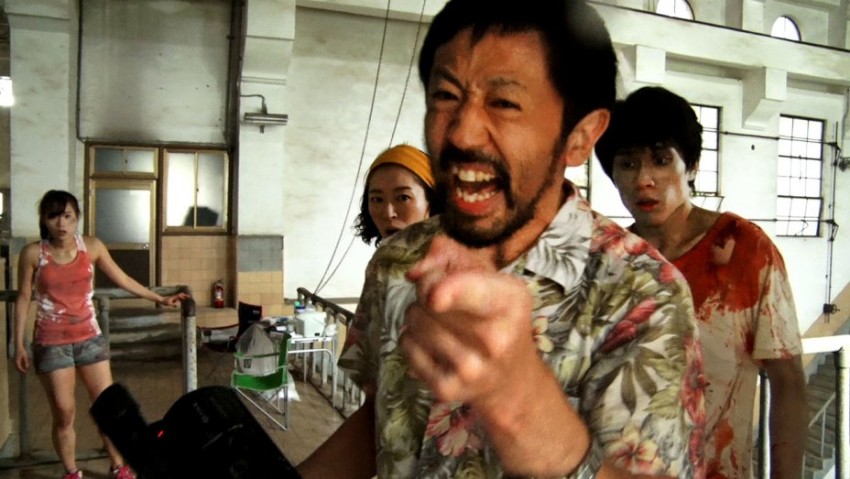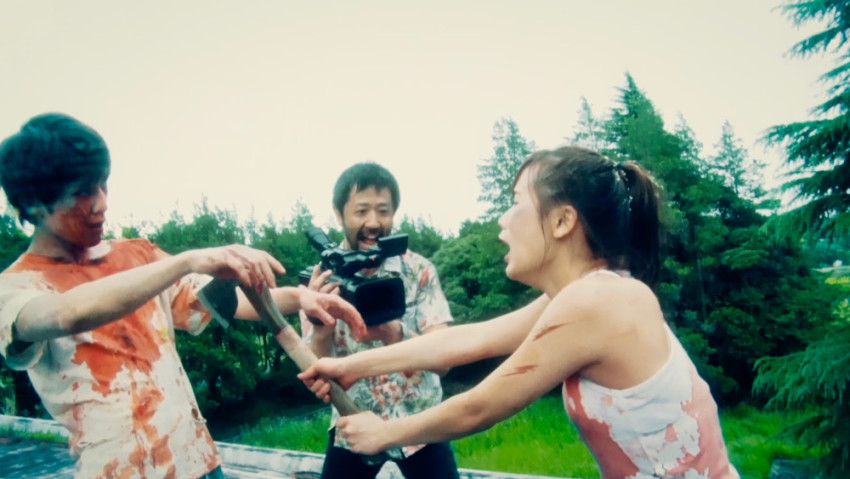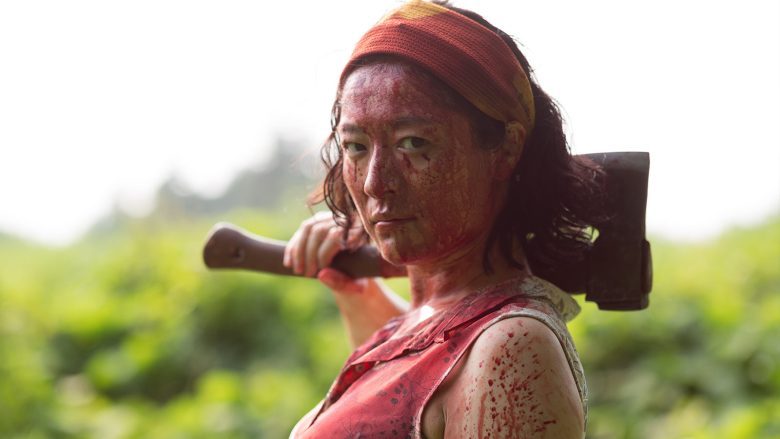One Cut of the Dead
December 27, 2018 · 4 comments
By Jasper Sharp.
 One Cut of the Dead, the ultra-savvy horror comedy that has been the talking point Japanese film of 2018, is getting a UK release in January to a handful of indie cinemas across the country courtesy of Third Window Films, which is also making it available on home video and VOD from 28th January 2019.
One Cut of the Dead, the ultra-savvy horror comedy that has been the talking point Japanese film of 2018, is getting a UK release in January to a handful of indie cinemas across the country courtesy of Third Window Films, which is also making it available on home video and VOD from 28th January 2019.
This cult hit by 34-year-old newcomer Shinichiro Ueda tracks the chaotic shoot of a one-take low-budget zombie flick in an abandoned warehouse location as the production threatens to go completely off the rails. Following a six-day run in just two Tokyo cinemas back in June, positive word of mouth about the film has spread like wildfire, with wider bookings and full houses across the country, leading to it riding high at the domestic box office throughout and well past the Summer months.
Following a world premiere at Udine Far East Film Festival in Italy back in April, it has picked up a raft of awards – crucially mostly audience awards – at some of the world’s most renowned Asian and genre film festivals, including New York Asian Film Festival, Camera Japan in Rotterdam, Fantastic Fest in Austin, Mexico’s Morbido, San Sebastian Horror Film Festival and Leeds Film Festival.
Not bad for a title with a no-name cast put together from a workshop at the Enbu Seminar school for wannabe film directors and performers on a budget of just 3 million yen – that’s around $27,000, or even less than your average pink film!
Just how far up the end-of-year Box Office rankings One Cut of the Dead eventually winds up remains to be seen. Though the final figures aren’t in yet, it is currently hovering just outside the top ten domestic grossers of the year – some way ahead of Hollywood blockbusters such as Solo: A Star Wars Story, Ready Player One, Deadpool 2 and Black Panther – while Mark Schilling reported in Variety on 23 October, four months after its release, that it was still playing on 293 screens across the country and had surpassed two million admissions. Taking its miniscule budget into account, one can already say that it is going to be the most profitable Japanese film of its year, if not the decade.
 So enough of the background puff story. Does One Cut of the Dead cut the mustard? Back in my days living in Tokyo, I remember having a conversation with an American critic at a festival about 28 Days Later (2002), the apocalyptic horror that marked something of a return to form for Trainspotting director Danny Boyle after a couple of duds. “How is it?”, I asked, intrigued by all the positive hubbub I’d seen online for a film that was still several months away from a Japanese release. “I’ve heard it’s really good.” “Well,” came the pithy reply, “you don’t want your zombie movies too good.”
So enough of the background puff story. Does One Cut of the Dead cut the mustard? Back in my days living in Tokyo, I remember having a conversation with an American critic at a festival about 28 Days Later (2002), the apocalyptic horror that marked something of a return to form for Trainspotting director Danny Boyle after a couple of duds. “How is it?”, I asked, intrigued by all the positive hubbub I’d seen online for a film that was still several months away from a Japanese release. “I’ve heard it’s really good.” “Well,” came the pithy reply, “you don’t want your zombie movies too good.”
It is the kind of cryptic rejoinder one might apply to One Cut of the Dead, although for entirely different reasons. This is a film made on very different means and to very different ends to Boyle’s deadly earnest take on post-millennium Britain. One could well argue to what extent Ueda’s take might even be described as a zombie movie, although pursuing this particular line of enquiry here would mean giving away vital spoilers.
We could equally situate One Cut of the Dead within other genres than the horror comedy, namely the “films, filmmakers or film personnel operating at the bottom rungs of the industry” category that Third Window seems to have a particular penchant for, with its own production of Lowlife Love (2015) accompanying such releases as Uzumasa Limelight (Ken Ochiai, 2014) and the behind-the-scenes exposés of the adult film industry of Antiporno (Shion Sono, 2016) and Make-Up Room (Kei Morikawa, 2014) – even Takeshi Kitano’s Getting Any? (1995) fits the bill to some extent.
What one can say for sure is that taken as a piece of micro-budget filmmaking, One Cut of the Dead is exhilarating, infectiously fun and endlessly inventive, to the extent that one is constantly guessing as to where it is headed. What other movies are bold enough to even think of breaking up the action for a credit sequence that appears roughly midway through the runtime?
Zombies don’t have much of a tradition in Japanese cinema. I am struggling to think of any titles of consequence prior to such postmodern examples as Tetsuro Takeuchi’s vehicle for gnarly three-piece rock outfit Guitar Wolf, Wild Zero (1999), the yakuza-zombie mashups of Junk (Atsushi Muroga, 2000) and Ryuhei Kitamura’s Versus (2000) and, at a stretch, the Resident Evil movies based on the Japanese videogame franchise directed by Paul W. S. Anderson from 2002 onwards.
 One Cut of the Dead riffs on the idea that the zombie movie represents something of a default for cash-strapped and unimaginative producers, a genre in which low-budgets can be worn as a badge of honour. Hands up who remembers the 2008 Tooting-set tale of terror that was Colin, the British budgetary race to the bottom whose miniscule £45 costs apparently just about covered a handful of camcorder tapes, a crowbar and a round of sandwiches? Or back in Japan, how about the campy trash aesthetics of Takao Nakano’s Big Tits Zombie 3D (2010), a film that pretty much failed to deliver on any one of the promises contained within its title?
One Cut of the Dead riffs on the idea that the zombie movie represents something of a default for cash-strapped and unimaginative producers, a genre in which low-budgets can be worn as a badge of honour. Hands up who remembers the 2008 Tooting-set tale of terror that was Colin, the British budgetary race to the bottom whose miniscule £45 costs apparently just about covered a handful of camcorder tapes, a crowbar and a round of sandwiches? Or back in Japan, how about the campy trash aesthetics of Takao Nakano’s Big Tits Zombie 3D (2010), a film that pretty much failed to deliver on any one of the promises contained within its title?
I should state straight away that Ueda’s film is in a different league entirely. Still, the film-within-a-film that comprises the bulk of its runtime, commissioned by a newly-launched fictional ‘Zombie Channel’, is essentially regarded as an inconsequential piece of screen filler by all concerned. Its director, Higurashi, is a self-effacing journeyman more familiar with the world of TV ads and karaoke videos, whose own modest tagline is “I’m fast, cheap, but average.” Still, perhaps this new project, 30 minutes of blood-drenched zombie-mashing mayhem shot completely without edits to be broadcast live, might offer an unlikely opportunity to shine, even if no one is watching? That is if the preening pop idol Aika and pretty-boy male lead Kazuaki don’t compromise his vision.
Ueda opens proceedings with Higurashi screaming at Aika for so pathetically failing to project any adequate intimation of terror as she cowers from the shambling advances of her zombified boyfriend (played by Kazuaki). It has been the 42nd take, we learn, although it at least turns out to be the final one here. The Japanese title Kamera o tomeru na! literally translates as ‘Don’t Stop the Camera!’, and this is exactly the tack taken as the action follows on breathlessly in unbroken single-shot mode while the first zombie assailants lurch into the warehouse to menace the handful of cast and crew members present on set.
 God only knows what is going on beyond the frame, but we soon learn that the derelict warehouse was rumoured to have been used for human experimentation of some unspecified nefarious nature. As the survivors are picked off one by one while fighting off and fleeing from the relentless waves of assault, Higurashi periodically disappears and re-emerges to film the carnage, thrusting both zombies and severed body parts towards his cast to shock them into action.
God only knows what is going on beyond the frame, but we soon learn that the derelict warehouse was rumoured to have been used for human experimentation of some unspecified nefarious nature. As the survivors are picked off one by one while fighting off and fleeing from the relentless waves of assault, Higurashi periodically disappears and re-emerges to film the carnage, thrusting both zombies and severed body parts towards his cast to shock them into action.
As all good cinephiles will be aware, there is an ineffable seat-of-the-pants excitement to the single-take film, which stems from the constant sense of camera motion thrusting us right into the subjective heart of the action and an awareness of the complexities of making sure everyone is in the right place at the right time and doesn’t screw things up by fluffing their lines or whatever. Think of Alexander Sokurov’s 96-minute odyssey through the labyrinthine interiors, teeming with crowds of costumed extras, of the Winter Palace in Saint Peterburg in Russian Ark (2002), or the vertiginous disembodied camera of Gaspar Noé’s cinematic acid trip Enter the Void (2009) as it explores every nook and cranny of its Tokyo locale.
The rather more modest ambitions of One Cut of the Dead, however, reminded me more of another great piece of Japanese indie filmmaking. Tetsuaki Matsue’s innovative low-fi music documentary Live Tape consisted entirely of folk singer Kenta Maeno performing with his guitar on New Year’s Day in 2009 as he wanders through the Tokyo suburb of Kichijoji for the 74-minute duration of digital video camera tape, occasionally stopping to jam with other musicians at key points on his route before all reunite for an exuberant climax in Inokashira Park.
One Cut of the Dead shares that same tight-rope frisson of the audience knowing that the whole exercise could topple at any moment during the filming (tempered by the obvious awareness that the fact you are watching it means it clearly didn’t), while marvelling at how the makers pulled off such a delicate balancing act in so entertaining a fashion with little else in the way of resources than sheer ingenuity.
It all seems to work particularly well in the context of a found footage horror movie. Here the hectic dynamism of following the characters as they scamper in terror around the undead-infested warehouse and its environs, fending off their attackers with axes and dropkicks, echoes the exhilarating pacing of a first-person shooter videogame, and what is left lingering out of shot might be far more terrifying than what appears onscreen.
 There is a certain level of playfulness in how the film’s makers go about their bloody business of creating convincing on-camera decapitations and picking off their characters, of which there are usually around three or four on the screen at any one time, so that, true to the usual genre logic, they themselves pop up from the edge of the frame re-animated, blood-spattered and minus a limb or two mere minutes later.
There is a certain level of playfulness in how the film’s makers go about their bloody business of creating convincing on-camera decapitations and picking off their characters, of which there are usually around three or four on the screen at any one time, so that, true to the usual genre logic, they themselves pop up from the edge of the frame re-animated, blood-spattered and minus a limb or two mere minutes later.
As a logistical exercise, the first half of One Cut of the Dead already impresses enough for one to forgive those brief pauses when it seems like the characters have temporarily fluffed their lines or are gazing off screen waiting for a cue hasn’t happened exactly as planned.
But then the narrative changes tack in a way that is so breathtakingly original and adroitly handled that not only are we treated to the backstory to what we have just seen, but an entire re-tread of the action that throws a hilarious new slant on every single gesture and every single moment to uproarious, ironic and ultimately surprisingly heart-warming effect.
What we effectively have here is a genuinely unique work whose success is so freak that, just like Tetsuo: The Iron Man at the tail end of the 1980s, it can never be a gamechanger for the general industry in the same way that Ring was, because it simply can’t be replicated. One Cut of the Dead is a real breath of fresh air. Proving there is still life in the dead, it is also far more than a mere zombie movie. At least three times more.
Jasper Sharp is the author of The Historical Dictionary of Japanese Cinema.
One Cut of the Dead screens in UK cinemas in January and is released on home video formats on 28th January.
Ryan Dave Jimenez
December 28, 2018 5:22 am
How long is this movie? 30 minutes?
andrew osmond
December 28, 2018 11:19 am
The film is 97 minutes in total, so it's normal feature-length. The "one cut" sequence is about a third of that.
Ryan Dave Jimenez
December 31, 2018 2:00 am
Oh ok. Thank you. This definitely piqued my interest.
Michael FM
January 16, 2019 11:23 am
No-name cast Jasper, maybe to you, Aika is Makota Okunaka former member of PASSPO and for more Zombie IDOL crossover there are the two BiS movies IDOL is dead and IDOL is dead - non chan no propaganda dai sensou (2014).